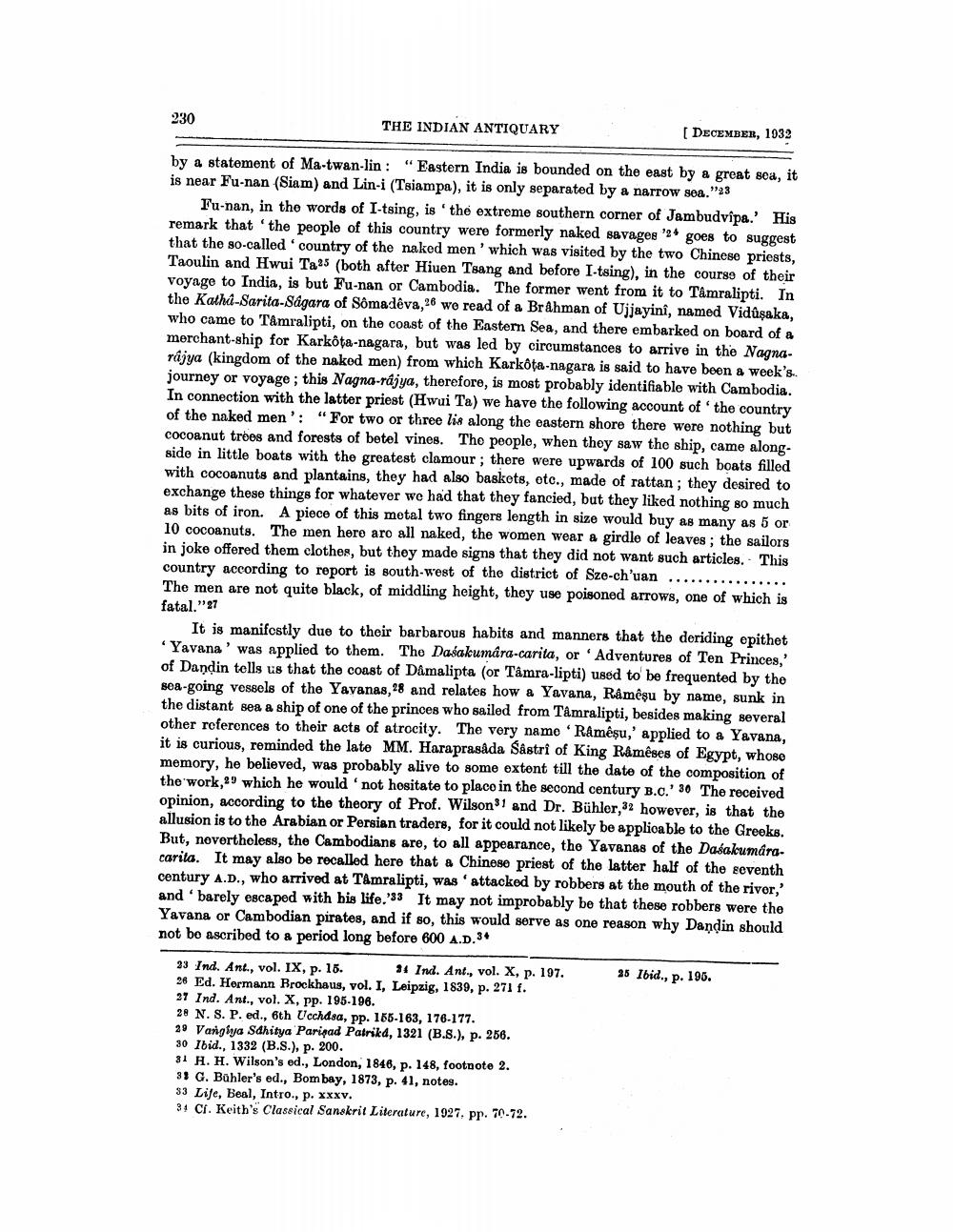________________
230
THE INDIAN ANTIQUARY
( DECEMBER, 1932
by a statement of Ma-twan-lin: "Eastern India is bounded on the east by a great sea, it is near Fu-nan (Siam) and Lin-i (Tsiampa), it is only separated by a narrow sea."23
Fu-nan, in the words of I-tsing, is the extreme southern corner of Jambudvipa.' His remark that the people of this country were formerly naked savages '* goes to suggest that the so-called country of the naked men 'which was visited by the two Chinese priests, Taoulin and Hwui Taas (both after Hiuen Tsang and before I-tsing), in the course of their voyage to India, is but Fu-nan or Cambodia. The former went from it to Tamralipti. In the Katha-Sarita-Sagara of Sômadêva, 26 we read of a Brahman of Ujjayini, named Vidûşaka, who came to Tamralipti, on the coast of the Eastem Sea, and there embarked on board of a merchant-ship for Karköta-nagara, but was led by circumstances to arrive in the Nagnarajya (kingdom of the naked men) from which Karköta-nagara is said to have been a week's. journey or voyage; this Nagna-rajya, therefore, is most probably identifiable with Cambodia. In connection with the latter priest (Hwui Ta) we have the following account of the country of the naked men': "For two or three lis along the eastern shore there were nothing but cocoanut trees and forests of betel vines. The people, when they saw the ship, came along. side in little boats with the greatest clamour; there were upwards of 100 such boats filled with cocoanuts and plantains, they had also baskets, etc., made of rattan; they desired to exchange these things for whatever we had that they fancied, but they liked nothing so much as bits of iron. A piece of this metal two fingers length in size would buy as many as 5 or 10 cocoanuts. The men here aro all naked, the women wear a girdle of leaves; the sailors in joke offered them clothes, but they made signs that they did not want such articles. This country according to report is south-west of the district of Sze-ch'uan ..... The men are not quite black, of middling height, they use poisoned arrows, one of which is fatal."27
It is manifostly due to their barbarous habits and manners that the deriding epithet 'Yavana' was applied to them. The Dasakumara-carita, or Adventures of Ten Princes,' of Dandin tells us that the coast of Dåmalipta (or Tâmra-lipti) used to be frequented by the sea-going vessels of the Yavanas, 28 and relates how a Yavana, Ramesu by name, sunk in the distant sea a ship of one of the princes who sailed from Tamralipti, besides making several other references to their acts of atrocity. The very name 'Ramêșu,' applied to a Yavana, it is curious, reminded the late MM. Haraprasada Sastri of King Rameses of Egypt, whose memory, he believed, was probably alive to some extent till the date of the composition of the work,2' which he would not hositate to place in the second century B.C.' 30 The received opinion, according to the theory of Prof. Wilson1 and Dr. Bühler, however, is that the allusion is to the Arabian or Persian traders, for it could not likely be applioable to the Greeks. But, nevertheless, the Cambodians are, to all appearance, the Yavanas of the Dasakumaracarita. It may also be recalled here that a Chinese priest of the latter half of the seventh century A.D., who arrived at Tamralipti, was attacked by robbers at the mouth of the river, and barely escaped with his life.'33 It may not improbably be that these robbers were the Yavana or Cambodian pirates, and if so, this would serve as one reason why Dandin should not bo ascribed to a period long before 600 A.D.34
35 Ibid., p. 195.
33 Ind. Ant., vol. IX, p. 15. 34 Ind. Ant., vol. X, p. 197. 26 Ed. Hermann Brockhaus, vol. I, Leipzig, 1839, p. 271 í. 37 Ind. Ant., vol. X, pp. 195.196. 28 N. S. P. ed., 6th Ucchdsa, pp. 155-163, 176-177. 29 Vangiya Sahitya Paripad Patrika, 1321 (B.S.), p. 256. 30 Ibid., 1332 (B.S.), p. 200. 31 H. H. Wilson's ed., London, 1846, p. 148, footnote 2. 33 G. Bühler's ed., Bombay, 1873, p. 41, notes. 33 Life, Beal, Intro., p. xxxv. 34 Cl. Keith's Classical Sanskrit Literature, 1927, pp. 70-72.




